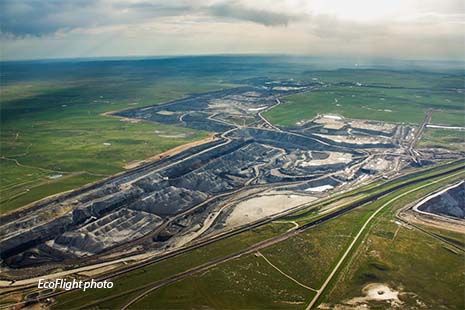Early this morning, once-giant coal mining company Arch Coal, Inc. filed for bankruptcy in St. Louis, Missouri. The move was widely anticipated following a missed interest payment to the company’s lenders in mid-December, but is nevertheless grim news for communities concerned about Arch’s coal mine cleanup liabilities.
Self-Bonding and Coal Cleanup Risk
Reclamation is the process of healing the land after blasting and excavation during strip-mining, and is one of the main liabilities facing coal companies. Because so much is at stake – and because of the industry’s past abandonment of mines – federal and state mining laws were created to require companies to post financial assurance for the full cost of mine cleanup, which amounts to almost $640 million for Arch. If companies walk away from their obligations, state agencies can seize the funds, known as reclamation bonds, to carry out cleanup activities.
Reclamation bonds are usually provided by banks or insurance companies. However, a loophole in the law allows states to accept so-called “self-bonds” – financial assurance based solely on the balance sheets of the mining company, rather than a third-party. In order to qualify for self-bonding, a company must meet certain financial benchmarks, one of which is a history of solvency. Sightline Institute recently posted a good explainer of self-bonds.
Arch Coal is the nation’s second largest coal producer and has operations in all major coal regions. Arch uses self-bonds only in Wyoming, but their self-bond liability in Wyoming is $458 million, which is over 70% of their total national reclamation liability.
In filing for bankruptcy, Arch wrote that it expects to be required to replace its $458 million of self-bonds. However, as opposed to committing to funding the full amount, Arch asked the court to designate $75 million to satisfy any demands for self-bond replacement by state and federal regulators. That Arch expects to settle its reclamation obligations during bankruptcy for a promise of 16¢ on the dollar is no surprise: regulators in Wyoming recently accepted a similar deal from bankrupt-Alpha Natural Resources, Inc., which filed for bankruptcy last August. According to Robert Godby, a professor who studies the energy industry at the University of Wyoming, Arch “clearly is in no position to honor its reclamation responsibilities should it have to.”
The federal rules never intended financially shaky companies to self-bond. As explained in 1983 when federal regulators established today’s self-bonding regulations,
The purpose of establishing a self-bond program is to recognize that there are companies that are financially sound enough that the probability of bankruptcy is small. A self-bond is allowed both because there are enough assets to allow reclamation in case of bankruptcy and because there is little probability of bankruptcy.
If a self-bonded mining company liquidated without selling its mines to other companies, the brunt of reclamation expenses would fall to taxpayers, if reclamation was even carried out. This, too, was foreseen by federal regulators:
In the event of bankruptcy, the regulatory authority would probably be in the position of an unsecured creditor. Typically, the regulatory authority would have to go through bankruptcy proceedings to secure payment on the [self-bond]. Bankruptcy proceedings are often lengthy and involved, and the regulatory authority could have to settle on less than 100% payment.
Arch Coal, Inc. has not met the financial requirements to self-bond for several years, but was able to use a loophole in the law that let one of its subsidiaries qualify, Arch Western Resources, LLC. Arch Western’s financials are not publicly available because they receive confidential treatment from state regulators in Wyoming. What is known is that Arch Western Resources was double-pledged: it guaranteed hundreds of millions in reclamation self-bonds while simultaneously serving as collateral to Arch Coal, Inc.’s giant corporate debt – the same debt that brought Arch Coal, and therefore Arch Western, to file for bankruptcy protection today. Federal and state regulators were repeatedly warned about the danger of this arrangement, including in a report released by WORC and its partners in June 2015 and a complaint filed under the federal Strip Mine Act.
Despite months of inaction, state and federal regulators can still reverse course. To ensure that cleanup for Arch’s mess won’t fall on taxpayers, regulators could still demand third-party reclamation bonds from the company. Guarantees by a solvent entity, like a bank or insurance company, are the only way to protect reclamation. Barring swift and decisive action, WORC members may have to pursue safe reclamation bonds through the ongoing bankruptcy proceedings.
Calling on regulators to enforce the law, Bob LeResche of Clearmont, Wyoming, said, ”Regulators must not allow Arch to shirk its responsibility to have adequate bonds for coal mine cleanup. Bankruptcy should not be used as a haven for the company to escape its obligations. With over ninety square miles of coal mines in Wyoming’s Powder River Basin, Arch has a $458 million reclamation liability. State and federal taxpayers must not be left with the bill.”
You can read a statement by WORC and the Powder River Basin Resource Council here.
Why Arch Failed: Collapsing Exports, Natural Gas, and Bad Bets
The financial distress signals for Arch and the coal industry as a whole have been ringing loud and clear for years. Coal just can’t compete with low natural gas prices, and utilities are increasingly turning to gas to service their needs. As Jim Thompson, a director at researcher IHS Coal, recently told the Wall Street Journal, “The price of coal in the U.S. is now capped by the gas price, and that’s a problem for coal companies.”
The prospects for coal internationally are not any better than they are domestically. The Institute of Energy Economics & Financial Analysis argues that the world is past “peak coal.” Once thought of as the savior of the industry, proposed coal export facilities in the Pacific Northwest and elsewhere have experienced multi-year delays and are now economically uncertain. Coal companies around the world are in financial freefall, with two-thirds of coal production across the globe currently not making a profit. China, the largest potential foreign market for US coal, has recently moved to cut their dependency on coal and India, one of the few countries with growing reliance on coal, has been increasing its focus on locally produced coal.
Specifically, Arch is a main partner in the proposed Millennium Bulk Terminals proposal in Longview, Washington. In announcing their 38% interest in the project in January 2011, Steven F. Leer, Arch’s then-chairman and chief executive officer, stated, “We believe this first project – along with others in the pipeline – will provide Arch with more exposure to the seaborne thermal market and will further unlock the value inherent in our western coal assets.” As Sightline Institute explains, Arch Coal’s bet on coal exports, and the Millennium Bulk proposal in particular, has simply not panned out and has significantly contributed to the financial shape the company is in today.
To underline the shift in thinking among Arch executives, the company today requested that the Missouri bankruptcy court overturn its prior commitments to export coal, canceling contracts with Kinder Morgan, a terminal services provider, Ridley Terminals, a British Columbia port, and major railroad companies. The contracts were deemed “not necessary” to the ongoing business operations or restructuring efforts” of the company, providing “no ongoing benefit” or “benefits that are substantially less than the corresponding costs.”
The Otter Creek Mine and Arch’s Plans for Montana
Also filing for bankruptcy alongside parent company Arch is its subsidiary Otter Creek Coal LLC, which is pushing the proposed strip mine in the Otter Creek valley in southeastern Montana. The mine project, which would require the construction of a railroad to move coal to market, is sited in a productive agricultural valley on land sacred to Northern Cheyenne people.
“This bankruptcy casts doubt on three major projects that affect eastern Montana,” said Mark Fix, a Northern Plains Resource Council member who farms and ranches on the Tongue River downstream from the proposed Otter Creek Mine, and could be crossed by the proposed Tongue River Railroad, which would condemn private ranch land to haul the mine’s coal. “The mine, the railroad and the proposed coal port in Longview, Washington, are all in serious doubt now. Montana should take this bankruptcy as a sign of the times, and make sure not to get in bed with a coal company that can’t even keep itself afloat.”
“I hope Arch uses this bankruptcy to uphold the company’s obligations to its miners and retirees, and to ensure that its mines across the country are reclaimed,” Fix continued, “but that’s probably an optimistic view. The federal government should step in to ensure that Arch doesn’t go the way of past bankrupt coal companies and abandon workers and the environment.”
What’s Next?
Arch’s bankruptcy may wipe clean its liabilities, but the company cannot control the production costs of ever-deeper coal or recover the coal prices of yesteryear. To exit bankruptcy, Arch will need to prove that its reorganization plan will launch a newly successful business. This may be a difficult task given that reorganized coal companies have returned to bankruptcy court in recent years, such as Patriot Coal Company and Fortress Resources.
Arch’s next steps are crucial. The rehabilitation of nearly dozens of square miles of Wyoming farm and rangeland hangs in the balance, as do plans for the industrial projects in the Tongue River and Otter Creek valleys.
Read more coal stories here.
Read more:
Investigation of Ramaco Principals Reveals Shady History
Current State of Coal Industry and Mineral Tax Collection Creates a Tax Time-bomb
Unanimous Vote by Wyoming Environmental Quality Council Clears the Way for Strong Self-Bonding Rules


